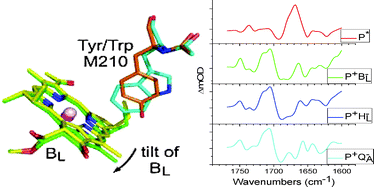Energy and electron transfer in a tyrosine M210 to tryptophan (YM210W) mutant of the Rhodobacter sphaeroides reaction center (RC) were investigated through time-resolved visible pump/mid-infrared (mid-IR) probe spectroscopy at room temperature, with the aim to further characterize the primary charge separated states in the RC. This mutant is known to display slow and multi-exponential charge separation, and was used in earlier work to prove the existence of an alternative route for charge separation starting from the accessory bacteriochlorophyll in the active branch, BL. The mutant RCs were excited at 860 nm (direct excitation of the primary donor (P) BChls (PL/PM)), 600 nm (unselective excitation), 805 nm (direct excitation of both accessory bacteriochlorophyll cofactors BL and BM) and 795 nm (direct excitation of BL). Absorption changes associated with carbonyl (C![[double bond, length as m-dash]](https://www.rsc.org/images/entities/char_e001.gif) O) stretch vibrational modes of the cofactors and protein were recorded in the region between 1600 and 1775 cm−1, and both a sequential analysis and simultaneous target analysis of the data were performed. The decay of P* in the YM210W mutant was multi-exponential with lifetimes of 29 and 63.5 ps. The decay of P+BL− state was ∼10 times longer in the YM210W RC than in the R-26 RC (∼7 ps vs. ∼0.7 ps), and in the mid-IR difference absorption spectrum of P+BL− the stretching frequency of the 9-keto C
O) stretch vibrational modes of the cofactors and protein were recorded in the region between 1600 and 1775 cm−1, and both a sequential analysis and simultaneous target analysis of the data were performed. The decay of P* in the YM210W mutant was multi-exponential with lifetimes of 29 and 63.5 ps. The decay of P+BL− state was ∼10 times longer in the YM210W RC than in the R-26 RC (∼7 ps vs. ∼0.7 ps), and in the mid-IR difference absorption spectrum of P+BL− the stretching frequency of the 9-keto C![[double bond, length as m-dash]](https://www.rsc.org/images/entities/char_e001.gif) O group of BL in the ground state was located around 1675–1680 cm−1, consistent with the presence of a hydrogen bond donated by an adjacent water molecule. Excitation at 795 nm produced a small amount of BL*-driven charge separation, as assessed from the excitation wavelength dependence of the raw difference spectra recorded during the first few ps after excitation. This process led to the formation of P+BL−. Only the relaxed form of the P+HL− radical pair was observed in the YM210W mutant, and the mid-IR difference absorption spectra of P+HL− and P+BL− showed a change in the relative amplitude of the PL+ and PM+ bands when compared to equivalent spectra for the R-26 RC. This indicates that the YM210W mutation causes an increased localization of the electron hole on the PM half of the dimer. The absorbance difference spectrum of P+HL− in the R-26 RC contains a feature attributable to a Stark shift of one or more amide C
O group of BL in the ground state was located around 1675–1680 cm−1, consistent with the presence of a hydrogen bond donated by an adjacent water molecule. Excitation at 795 nm produced a small amount of BL*-driven charge separation, as assessed from the excitation wavelength dependence of the raw difference spectra recorded during the first few ps after excitation. This process led to the formation of P+BL−. Only the relaxed form of the P+HL− radical pair was observed in the YM210W mutant, and the mid-IR difference absorption spectra of P+HL− and P+BL− showed a change in the relative amplitude of the PL+ and PM+ bands when compared to equivalent spectra for the R-26 RC. This indicates that the YM210W mutation causes an increased localization of the electron hole on the PM half of the dimer. The absorbance difference spectrum of P+HL− in the R-26 RC contains a feature attributable to a Stark shift of one or more amide C![[double bond, length as m-dash]](https://www.rsc.org/images/entities/char_e001.gif) O oscillators. This feature was shifted to lower frequency by ∼5 cm−1 in the YM210W RC, and consideration of the limited structural changes in this RC indicates that this feature arises from an amide C
O oscillators. This feature was shifted to lower frequency by ∼5 cm−1 in the YM210W RC, and consideration of the limited structural changes in this RC indicates that this feature arises from an amide C![[double bond, length as m-dash]](https://www.rsc.org/images/entities/char_e001.gif) O group in the immediate vicinity of the M210 residue, most probably that of the adjacent M209 amino acid.
O group in the immediate vicinity of the M210 residue, most probably that of the adjacent M209 amino acid.

You have access to this article
 Please wait while we load your content...
Something went wrong. Try again?
Please wait while we load your content...
Something went wrong. Try again?
![[double bond, length as m-dash]](https://www.rsc.org/images/entities/char_e001.gif) O) stretch vibrational modes of the
O) stretch vibrational modes of the ![[double bond, length as m-dash]](https://www.rsc.org/images/entities/char_e001.gif) O
O ![[double bond, length as m-dash]](https://www.rsc.org/images/entities/char_e001.gif) O oscillators. This feature was shifted to lower frequency by ∼5 cm−1 in the YM210W RC, and consideration of the limited structural changes in this RC indicates that this feature arises from an
O oscillators. This feature was shifted to lower frequency by ∼5 cm−1 in the YM210W RC, and consideration of the limited structural changes in this RC indicates that this feature arises from an ![[double bond, length as m-dash]](https://www.rsc.org/images/entities/char_e001.gif) O
O 

 Please wait while we load your content...
Please wait while we load your content...